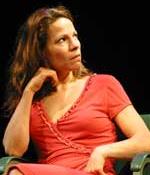SITE GUIDE
REVIEWS
FEATURES
NEWS
Etcetera and
Short Term Listings
LISTINGS
Broadway
Off-Broadway
NYC Restaurants
BOOKS and CDs
OTHER PLACES
Berkshires
London
California
DC
Philadelphia
Elsewhere
QUOTES
On TKTS
PLAYWRIGHTS' ALBUMS
LETTERS TO EDITOR
FILM
LINKS
MISCELLANEOUS
Free Updates
Masthead
Writing for Us
A CurtainUp Review
Landscape of the Body
|
The Williamstown Production Comes to Off-Broadway's Signature Theatre As the audience enters, the stage of the Signature Theatre's Peter Norton Space is blocked by a wall that announces (in huge bulb-lit letters) the year in which Landscape of the Body is set: 1977. Most of the play takes place, we will soon learn, in the far west end of Greenwich Village. The importance of the year will become clear in short order. This is not the West Village we know today, home to trendy restaurants and multi-million dollar condos; its denizens in 1977 were roving gangs of teenagers on the streets, rough trade cruising deserted piers and decapitated bodies floating in the river. This transformation was not known when John Guare wrote this play and it was first presented. But it goes right to the core of what his play is about. In an interview in the Signature's newsletter, Guare notes: "You can't live in the past in this city, you can't lament and say 'Oh, oh, oh.' It's just not there anymore. New York forces you to do the most challenging thing -- accept reality." Betty, the central figure in Landscape, learns this lesson the hard way: the sister that draws her to New York from Maine has been killed in a freak accident, the owner of the business for which she works is shot to death in a putative bank holdup that he unwittingly sets in motion, her only son is decapitated while she is away on a flawed journey to what she thinks will be a better life for both of them. There is only one thing she can do: move on. Our review of the original production, which included the same actors portraying three of the most important characters, provides plenty of detail on the basics of this show and on the complex dramatic forms with which John Guare toys in constructing it. Elyse Sommer comments on the confusion this seems to cause the audience (including, presumably, her). The fault does not lie in the play, however, but in the way that Michael Greif has directed it. The beauty of John Guare is that, under his inventive plot twists and quirky characters, one finds truth. Instead of rooting performances in the underlying reality of the characters, Greif tries to outmaneuver Guare, having the actors perform in a highly stylized (not to mention inconsistent and discombobulating) manner. The end product competes with rather than illuminates the work. It does not help that Greif also emphasizes performance to such an extent that any attention an actor might devote to Guare's often elegant text is quickly swept aside. (Why, moreover, do we have actors voices miked in a space that surely does not require such amplification?) This is largely the same production as that seen at Williamstown in the summer of 2003. Paul Sparks, new to the role of Holahan, is quite fine, and is particularly poignant in the play's final scenes. Bernard White's Raulito is also good, and perhaps less over-the-top than the original, about which Elyse Sommer complained below. And the four teens in this production, Paul Iacono, Jill Shackner, Colby Minifie and especially Stephen Scarpulla as Bert, couldn't be better. This is a peculiar but extremely thoughtful play, and Signature is to be commended for bringing it to us. It informs our understanding of the playwright we know best in terms of his masterpieces, Six Degrees of Separation and House of Blue Leaves. But Landscape of the Body deserves better than it gets here. Changes in Credits Since Williamstown
New cast members: Paul Sparks (Captain Marvin Holahan), Bernard White (Raulito), Stephen Scott Scarpulla (Bert), Paul Iocono (Donny), Jill Shackner (Joanne), Colby Minifie (Margie), Brian Sgambati (Masked Man/Dope King of Providence/others)New band members: Ernie Adzentoivich (Bass), Mike Cohen (Reeds) and Richard Huntley (Percussion) Costume Design: Miranda Hoffman Lighting Design: Howell Binkley Sound Design: Brett R. Jarvis Fight Direction: Rick Sordelet Running time: 2 hours, 15 minutes with 1 intermission Signature Theatre, 555 West 42nd Street (10/11 Avs) Telephone (212) 244-7529 Opening April 16, 2006, closing May 21, 2006 TUE - SAT @8, SAT - SUN @3; $15 Re-reviewed by Les Gutman based on 4/10/06 performance |
---Original Berkshires Review Follows---
|
It's amazing how a little tomorrow can recompense a lot of sorrow --- from one of Rosalie's songs |

S. R. Scott
(Photo: Richard Feldman) |
The Williamstown Theatre Festival's production is likely to divide audiences between new converts and those scratching their heads over what to make of this multi-faceted play. Whatever camp you join, you'll have to agree that you couldn't hope for two more perfectly cast leads than Sherie Rene Scott, who deserves to have a major musical written for her, as the chanteuse/narrator Rosalie, and Lili Taylor as her sister Betty.

L. Taylor
(Photo: Richard Feldman) |
The real puzzle is how one playwright can juggle so many creative ideas, forging a witty and unique script from a sordid headline murder case and accenting it with original music and lyrics. While at times overly ambitious, I for one always enjoy watching Guare's fertile imagination at work and am glad to have had the opportunity to catch up with this previously unseen play.
Like much of this versatile playwright's work, Landscape is full of quirks and word play, the latter starting with the surname Yearn which so aptly describes the journey that sends the main character, Betty, from Maine to Greenwich Village to reaffirm ties with her sister Rosalie, only to find herself coping with death rather than renewal. Besides specific encounters with death -- Rosalie being senselessly killed by a cyclist, the man she works with the hapless victim of a prank, her teen aged son murdered -- there is the metaphoric death of hope and the sense of human connectedness.
Like Mary Higgins Clark, for whom it became the first of countless best selling murder mysteries (Where Are the Children which is still in print), Guare was inspired by the Alice Crimmins case which dominated the headlines and tabloids for years. Crimmins, a young Queens mother with a less than pure as the driven snow reputation, was indicted for the murder of her two children and Guare, according to an interview in the always interesting WTF program notes, saw her being taken to the Women's House of Detention in his downtown Manhattan neighborhood. That combined with the presence of some young teen aged hoods who were part of a disturbingly uncivilized new element in that same neighborhood set Guare to thinking -- and writing.
The play unfolds mostly in Greenwich Village where Guare first saw Crimmins in the flesh and also the kids with the watches who cause the murder and mayhem that cast suspicion on Betty. The multiple flashback format begins and ends with Betty on a ferry headed for Nantucket, stuffing bits of paper on which she has scribbled her history into bottles and tossing them over the rail as a man with a false nose tries to pick her up. Guare watchers will not be surprised by this over-the-top character or that he turns out to be Captain Marvin Holahan (Michael Gaston), the policeman who has relentlessly interrogated Betty about the death of her son Bert (Joseph Cross).
As a back panel closes on the blue sky view from the ferry, the story moves back in time, with the appearance of the dead Rosalie -- a lively and sexy blonde ghost who with word and song takes us back step by step, beginning with Betty and Bert arriving in Rosalie's Greenwich Village apartment from Bangor, Maine. After Rosalie's life is crushed beneath a careless bicyclist's wheels and with it the dream of renewed family ties, we see Betty step into her sister's shoes as a porn film actress and also becomes involved in a con game run by Raulito (Jose Zuniga), a transvestite. Young Bert also gets hooked into this fast-paced, foreboding existence that leads to the ultimate tragedy of his violent end and Captain Holahan's determination to blame it on his mother.
Rosalie segues from cabaret style MC-Narrator to her flesh and blood interactions with Betty and Bert. The latter include a pivotal visit from Durwood Peach (Jonathan Fried), an old suitor who seems to have wandered in from a Tennessee Williams play. The daffy Peach gets to explain the title when he declares that he would give up his mansion in a minute since the only landscape he cares about is the "landscape of the body." Finally there's the scene of Bert's murder, which will remain a mystery to all but those who have moved to Rosalie's universe.
Michael Gaston does a good job as the gung-ho police captain and the various secondary characters give credible performances, though Jose Zuniga is a bit too cartoonish as the hapless transvestite, and Stephen DeRosa's talents are under-utilized in three minor roles. Ultimately this is the two sisters' show, and most of all Sherie Rene Scott's.
Director Michael Greif, who seems never to have come across a play that could not use some sort of scaffolding, here provides a nifty scaffold-like platform for Ms. Scott to climb to her heavenly perch which also accommodates the excellent four-piece band.
Landscape of the Body never was or will be your easily categorized and understood kitchen sink play. But if you can buy into John Guare's amalgam of murder mystery, oddball love story and vaudeville-cabaret, you'll view your ticket as buying you several plays for the price of one.
Landscape of the Body Book, Music, and Lyrics by John Guare Directed by Michael Greif Cast: Joseph Cross (Raulito), Stephen DeRosa (Masked Man/Dope King/Bank Teller), Jonathan Fried (Durwood Peach), Michael Gaston (Captain Marvin Holahan), Kate Mare (Joanne), Gabriel Millman (Donny), Hayden Panettiere (Joanne)a, Sherie Rene Scott (Rosalie), Lili Taylor (Betty) Jose Zuniga (Raulito) Sets: Allen Moyer Costumes: Candice Donnelly Lighting: Kenneth Posner Sound: Matthew Burton Musical Director & Additional Music: Michael Friedman Band: Michael Friedman/piano; David G. Cohen/saxophone; Richard L. Huntley/percussion; Steve Murray/bass Running Time: 2 hours and 10 minutes (act one 80 minutes, act two 33 minutes), plus one 15-minute intermission July 9 to July 20, 2003 Tuesday through Friday, 8:30 p.m.; Saturday matinees, 4 p.m.; Sunday, 2 p.m. Tickets: $20-$53 1000 Main Street, Williamstown, MA (413/597-3400) web address Reviewed by Elyse Sommer based on 7/12 performance |

6, 500 Comparative Phrases including 800 Shakespearean Metaphors by our editor.
Click image to buy.
Go here for details and larger image.






